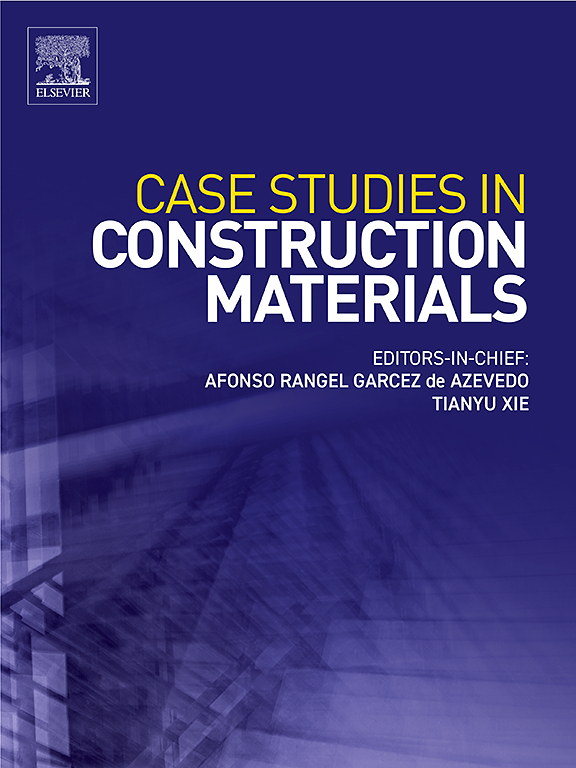Effect of foaming agent on the mechanical properties of red mud included controlled low-strength material CLSM
IF 6.6
2区 工程技术
Q1 CONSTRUCTION & BUILDING TECHNOLOGY
引用次数: 0
Abstract
There has been a growing interest in controlled low strength material CLSM due to its engineering features, such as self-leveling and early strength development, as well as it potential for utilizing industrial waste. Still, the dynamic properties on CLSM are rarely studied. This study evaluates the feasibility of red mud as a partial aggregate replacement in foamed-lightweight CLSM, incorporating high-carbon fly ash and preformed foam. We varied both the red mud contents RMc and foam volume ratio FVR within the mixtures and examined their impact on unconfined compressive strength and dynamic properties including shear modulus G and damping ratio D. The results reveal that the red mud enhances foam stability, leading to more uniform pore structures and increased porosity, which reduces bulk densities. Despite higher porosity, red mud serves as a strong alkaline activator, enhancing geopolymer reactions of high-carbon fly ash and thereby increasing both compressive strength and initial shear modulus G0. Interestingly, increasing FVR had minimal impact on the D, while higher RMc notably increased D, highlighting its distinct role in energy dissipation. The red mud-incorporated foamed CLSM exhibits strain-dependent normalized shear modulus G/G0 comparable to that of gravel, while its D is 40–100 % higher than gravel or gravelly soil at shear strain of 1⸱10−5, which corresponds to typical traffic-induced vibration levels. Moreover, theoretical volumetric-gravimetric relationships are introduced to account for the combined effects of FVR and RMc on CLSM behavior. These findings demonstrate that the red mud included foamed CLSM can be utilized as advanced structural backfill material capable of effectively mitigating the vibrations induced by traffic, low-amplitude seismic events, and mechanical sources.
发泡剂对赤泥力学性能的影响包括可控低强度材料CLSM
由于其工程特性,如自流平和早期强度发展,以及利用工业废料的潜力,人们对可控低强度材料CLSM的兴趣日益浓厚。然而,对CLSM的动力学特性研究却很少。本研究评估了赤泥作为泡沫轻质CLSM中部分骨料替代的可行性,其中掺入了高碳粉煤灰和预成型泡沫。研究了赤泥含量RMc和泡沫体积比FVR对混合物无侧限抗压强度、剪切模量G和阻尼比d等动态特性的影响。结果表明,赤泥增强了泡沫稳定性,使孔隙结构更加均匀,孔隙度增加,从而降低了体积密度。赤泥虽然孔隙度较高,但作为强碱性活化剂,增强了高碳粉煤灰的地聚合物反应,从而提高了抗压强度和初始剪切模量G0。有趣的是,增加FVR对D的影响很小,而更高的RMc显著增加了D,突出了其在能量消耗中的独特作用。红泥泡沫CLSM的归一化剪切模量G/G0与碎石相当,而在1⸱10−5剪切应变时,其D比碎石或砾石土高40-100 %,对应于典型的交通诱发振动水平。此外,引入了理论体积-重量关系来解释FVR和RMc对CLSM行为的联合影响。这些研究结果表明,含泡沫CLSM的赤泥可以作为先进的结构回填材料,能够有效地减轻交通、低振幅地震事件和机械源引起的振动。
本文章由计算机程序翻译,如有差异,请以英文原文为准。
求助全文
约1分钟内获得全文
求助全文
来源期刊

Case Studies in Construction Materials
Multiple-
CiteScore
7.60
自引率
19.40%
发文量
842
审稿时长
63 days
期刊介绍:
Case Studies in Construction Materials provides a forum for the rapid publication of short, structured Case Studies on construction materials. In addition, the journal also publishes related Short Communications, Full length research article and Comprehensive review papers (by invitation).
The journal will provide an essential compendium of case studies for practicing engineers, designers, researchers and other practitioners who are interested in all aspects construction materials. The journal will publish new and novel case studies, but will also provide a forum for the publication of high quality descriptions of classic construction material problems and solutions.
 求助内容:
求助内容: 应助结果提醒方式:
应助结果提醒方式:


